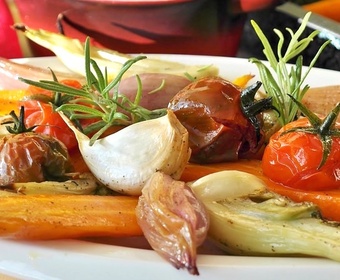
COOKING VEGETABLES
- Give vegetables your full attention.
- Think, texture, contrasts, garnish.
- Flavor enhancers are definitely allowed.
- Think differently, see meat as an accompaniment and a spice.
- Oven baking concentrates flavors.
It’s a long time since vegetables were something you just boiled and plonked on the table. Influences from foreign cuisines, vegetarians, vegans, the raw food movement, etc. have led to massive changes and refinements. And the need to eat less meat and more seasonal food for the sake of the environment is a factor too. Some of the tips from the professionals on how you can become part of this trend:
Be in the moment
Use simple techniques. It might sound a bit romantic, but professional chefs we’ve interviewed talk more about being “in the moment”, “present” than about what is right or wrong. Work carefully, smell, touch and feel, taste and pay attention to times and temperatures. That’s what makes the difference.
Don’t get hung up on what it’s supposed to be like. It’s OK to treat vegetables as if they were meat...
– Joel Aronsson, Fäviken, Krakas, and other restaurants
Think texture
Vegetables with a bit of crispy bite are nice – but that isn’t the whole picture. Some vegetables, such as broccoli, carrots and green beans absorb dressing and flavors better if they have been cooked until they are slightly soft.
Think garnish
A small, crispy, flavored accent can make even the most ordinary vegetable more interesting. Crispy fried bacon, fried and spiced bread, roasted nuts, roasted onions, a parmesan cheese topping, etc.
Think flavor enhancers
Glutamate and peptides produce a umami flavor, which in turn enhances the aromas in the food. But don’t think about the sort of glutamate that comes in a tin. There are natural flavor enhancers in your pantry: Anchovies, parmesan, soy sauce, fish sauce, etc. And fat, salt, sugar, chili, honey, vinegar, etc. Go for it.
Salt, oil, vinegar
These three are a perfect trio when enhancing the flavor of vegetables. Trust your instincts.
Think either/or
When it comes to vegetables it’s a bit like red meat: Either they need a high temperature for a short time, like in a wok, or you need to let them simmer for a long time until they’re soft and flavorsome, like in a curry. (Or you shouldn’t cook them at all...)
Think different
Take a leaf out of the book of modern chefs: See the vegetables as the main event on the plate and use the protein as a spice and flavor enhancer.
Put the focus on the vegetables and the herbs, let the meat be the garnish.
– Chef Abbe Lindo, Austin Foodworks
“Think like meat”
Chef Joel Aronsson thinks that many people make the mistake of treating vegetables differently, like something that needs to be sweated and stuffed and demands painstaking preparation. He thinks that you can treat plenty of vegetables the same way you do meat: Cut into reasonably sized slices and fry quickly on both sides for flavor and texture. Or do it the other way round: Bake whole root vegetables slowly in the oven as if they were a roast. Try out different things, vegetables don’t bite.
Many textures
Work with different textures in the same dish. The texture is affected by the cooking time and the cooking method. The same vegetable – depending on whether you add it at the beginning or at the end – can offer completely different tastes and mouth feel.
Baking means concentration
One basic tip (to which there are plenty of exceptions) is that you shouldn’t boil your vegetables. They already contain a lot of water and rarely benefit from more of it. Baking them in the oven, for example, has the opposite effect. Some of the water evaporates and the great flavors become more concentrated.
The art of boiling
Make sure that there are different textures, even in a stew made from nothing but vegetables. Add one ingredient at the start, another halfway through and a third at the end. Finally add fried onion for sweetness.
Steam crispy vegetables:
One trick when boiling/steaming new spring vegetables and other crisp vegetables (in small pieces): Put them in 3 mm water in a saucepan. Once the water has boiled away – it takes about a minute – you know they’re done. You don’t need anything else.
Cooking au gratin and on budget
Almost any vegetables are good if you put them in a dish, top with a great-tasting cheese and brown it in the oven. This method works well with the less great-looking – but nevertheless tasty – ends of vegetables and cheese that you’ve been saving in the fridge.
Grate that end of blue cheese over the top and you’re home and dry.
– Per Renhed
Make a big batch
Whatever you do with your vegetables, cook a large amount and use it all week.
Empty the fridge of vegetables
Make a purée: boil carrots or parsnips until soft, run through a food processor and add salt, cider vinegar and harissa. Jerusalem artichokes, cabbage, parsley root and sweet potatoes also make a good purée.
The most common amateur error
According to the professional chefs we asked, the most common error made by amateurs is not to boost the flavor of vegetables on the plate. People marinate meat and fish, and season them with salt and pepper and spices but when it comes to vegetables people are restrained to the point of inaction. Risk heightening flavor with salt, acidity, sugar, fat, chili etc!
Boost the flavor of your ingredients!
– Jole Aronsson


